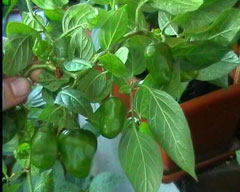 |
|
http://commons.wikimedia.org/wiki/User:Pepre |
 |
|
Translate this page:
Summary
Physical Characteristics

 Capsicum pubescens is a PERENNIAL growing to 3 m (9ft) by 2 m (6ft).
Capsicum pubescens is a PERENNIAL growing to 3 m (9ft) by 2 m (6ft).
See above for USDA hardiness. It is hardy to UK zone 9 and is frost tender. It is in flower from August to September. The species is hermaphrodite (has both male and female organs).
Suitable for: light (sandy), medium (loamy) and heavy (clay) soils and prefers well-drained soil. Suitable pH: mildly acid, neutral and basic (mildly alkaline) soils and can grow in very acid and very alkaline soils.
It cannot grow in the shade. It prefers moist soil.
UK Hardiness Map
US Hardiness Map
Synonyms
Brachistus lanceifolius. Capsicum lanceifolium. Capsicum violaceum
Plant Habitats
Cultivated Beds; South Wall. By. West Wall. By.
Edible Uses
Edible Parts: Fruit
Edible Uses: Condiment
Fruit - raw or cooked[238]. The distinctive thick-fleshed pungent fruits are used as a vegetable condiment or made into a sauce[183]. A hot pungent flavour, it is mainly used as a flavouring in cooked foods[238]. In Peru the seeds are removed, the fruit stuffed with a savoury filling and then baked[183]. The fruit can be dried and ground into a powder for use as a pepper-like condiment[238].
References More on Edible Uses
Medicinal Uses
Plants For A Future can not take any responsibility for any adverse effects from the use of plants. Always seek advice from a professional before using a plant medicinally.
Antihaemorrhoidal Antirheumatic Digestive Irritant Rubefacient Sialagogue
The hot and pungent fruit is antihaemorrhoidal when taken in small amounts, antirheumatic, antiseptic, diaphoretic, digestive, irritant, rubefacient, sialagogue and tonic[7, 238]. It is taken internally in the treatment of the cold stage of fevers, debility in convalescence or old age, varicose veins, asthma and digestive problems[238]. Externally it is used in the treatment of sprains, unbroken chilblains, neuralgia, pleurisy etc[238]. The German Commission E Monographs, a therapeutic guide to herbal medicine, approve Capsicum for muscular tension, rheumatism (see [302] for critics of commission E).
References More on Medicinal Uses
The Bookshop: Edible Plant Books
Our Latest books on Perennial Plants For Food Forests and Permaculture Gardens in paperback or digital formats.

Edible Tropical Plants
Food Forest Plants for Hotter Conditions: 250+ Plants For Tropical Food Forests & Permaculture Gardens.
More

Edible Temperate Plants
Plants for Your Food Forest: 500 Plants for Temperate Food Forests & Permaculture Gardens.
More

More Books
PFAF have eight books available in paperback and digital formats. Browse the shop for more information.
Shop Now
Other Uses
The growing plant repels insects[20].
Special Uses
References More on Other Uses
Cultivation details
Requires a very warm sunny position and a fertile well-drained soil. Tolerates a pH in the range 4.3 to 8.3. This species is only likely to be hardy in the milder areas of Britain, it can tolerate temperatures down to at least -5°c[238]. It might be possible to get it to fruit outdoors in the mildest areas of the country, especially if given the protection of a sunny wall[K]. Plants are able to continue fruiting for 15 years in cool moist climates[238].
References Carbon Farming Information and Carbon Sequestration Information
Temperature Converter
Type a value in the Celsius field to convert the value to Fahrenheit:
Fahrenheit:
The PFAF Bookshop
Plants For A Future have a number of books available in paperback and digital form. Book titles include Edible Plants, Edible Perennials, Edible Trees,Edible Shrubs, Woodland Gardening, and Temperate Food Forest Plants. Our new book is Food Forest Plants For Hotter Conditions (Tropical and Sub-Tropical).
Shop Now
Plant Propagation
Seed - sow late winter to early spring in a warm greenhouse[138]. The seed usually germinates in 3 - 4 weeks at 20°c. Prick out the seedlings into individual pots of reasonably rich soil and grow them on fast. If trying them outdoors, then plant them out after the last expected frosts and give them the protection of a cloche or frame at least until they are established and growing away well.
Other Names
If available other names are mentioned here
Native Range
NORTHERN AMERICA: Mexico SOUTHERN AMERICA: Central America, South America (Andean)
Weed Potential
Right plant wrong place. We are currently updating this section.
Please note that a plant may be invasive in one area but may not in your area so it's worth checking.
Conservation Status
IUCN Red List of Threatened Plants Status :

Growth: S = slow M = medium F = fast. Soil: L = light (sandy) M = medium H = heavy (clay). pH: A = acid N = neutral B = basic (alkaline). Shade: F = full shade S = semi-shade N = no shade. Moisture: D = dry M = Moist We = wet Wa = water.
Now available:
Food Forest Plants for Mediterranean Conditions
350+ Perennial Plants For Mediterranean and Drier Food Forests and Permaculture Gardens.
[Paperback and eBook]
This is the third in Plants For A Future's series of plant guides for food forests tailored to
specific climate zones. Following volumes on temperate and tropical ecosystems, this book focuses
on species suited to Mediterranean conditions—regions with hot, dry summers and cool, wet winters,
often facing the added challenge of climate change.
Read More
Expert comment
Author
Ruiz.&Pav.
Botanical References
200
Links / References
For a list of references used on this page please go here
Readers comment